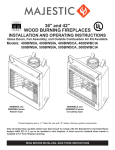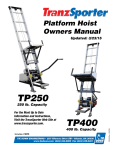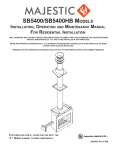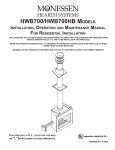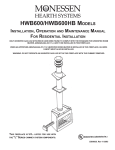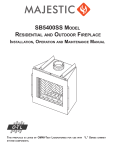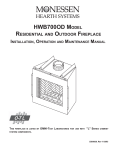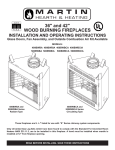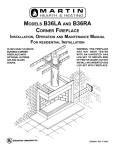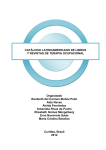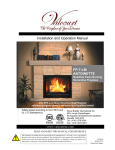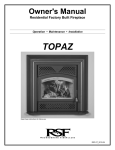Download MODEL MPL PENINSULA
Transcript
MODEL MPL PENINSULA INSTALLATION, OPERATION AND MAINTENANCE MANUAL Peninsula Style Fireplace THIS FIREPLACE IS LISTED BY OMNI-TEST LABORATORIES FOR USE WITH "L" SERIES CHIMNEY SYSTEM COMPONENTS. GLASS DOORS ARE REQUIRED ON THIS MODEL FIREPLACE 53D9042. Rev 1 03/03 CONGRATULATIONS! You have chosen the finest wood burning fireplace available. Your fireplace has been designed for years of heating and viewing enjoyment. Please take time to read this entire manual before installing or operating your fireplace. TABLE OF CONTENTS Listing and Code Approvals........................................................................................................................1 Important Information.................................................................................................................................2 Operation Guidelines.................................................................................................................................3 Clearances ........................................................................... ................................ ......4-5 Fireplace Location ................................................................................................................6 Installation Preparation ........................................................................................................7-8 Floor Protection ... ...............................................................................................................9-10 Fireplace Components ...................................................................................................11 Fireplace Installation .....................................................................................................12 Chimney Installation ...........................................................................................................................12-14 Chimney Offset Installation ............................................................................................15-16 Chimney Cap Installation ...................................................................................................................17-18 Chimney Cap Chase Installation ............................................................................................................19 Outside Combustion Air Precautions and Recommendations ...........................................................20-21 Combustion Air Assembly ......................................................................................................................22 Gas Appliance Installation .................................................................................................................23-24 Trim and Door Installation .......................................................................................................................25 Fireplace Operation ...........................................................................................................................26-27 Maintenance and Safety .....................................................................................................................28-30 Repair Parts Diagram and List .................................................................. .............................................31 Warranty..............................................................................................................................................33-34 LISTING AND CODE APPROVALS The instructions contained in this manual provide the information necessary to install this fireplace in accordance with OMNI-Test Laboratories requirements as tested to Underwriters Laboratories, Inc. standard for factory built fireplaces-U.L.127, and in compliance with the National Fire Protection Association Standard No. 211. Before beginning the installation, you should check with local building officials to obtain required permits and assure compliance with local regulations and coded. If you encounter problems with code requirements, contact your dealer for assistance. The design of this fireplace and these instructions complied with applicable safety standard for a factory built fireplace in effect at the time the fireplace was manufactured. You should be aware, however, that failure to install, operate, and maintain this or any other factory built fireplace properly can result in a house fire or other occurrences that could cause deaths, injuries, and property damages. It is very important that the persons installing and/or supervising the installation of this fireplace have appropriate skills in using the tools and techniques required; and reading and comprehension skills sufficient to read and follow these instructions. These instructions contain warnings, cautions, and notes to emphasize important safety information. To assure that safe and satisfactory service is received from this fireplace, please read the following special notices and all the contents of this manual. 1 53D9042. Rev 1 03/03 2 IMPORTANT INFORMATION 1. Read these instructions entirely before beginning any part of the installation. Save these instructions for any future repairs. 2. Use these instructions as a guide during the installation of the fireplace. 3. Be sure these instructions become the property of and are reviewed by all future users of this fireplace to encourage proper operation and maintenance. 4. All the parts used with this fireplace system must be installed in accordance with these installation instructions. Failure to do so may be hazardous and will void the warranty. 5. This fireplace and accessories should not be altered in any way that is not specifically recommended in this manual. 6. Refer to your local building code for local requirements pertaining to installation of factory-built fireplaces. Fireplaces are intended for installation and use according to standard NFPA NO.211 of the National Fire Protection Association. 7. This fireplace must not be installed with a masonry flue. 8. This fireplace and chimney should not be used for venting a wood or coal burning heater or fireplace insert. Warning: Do not install a separate solid fuel insert or gas fireplace insert into this fireplace and chimney system without written authorization . 9. Warning: Do not pack required air spaces with combustible material or insulation not specifically recommended for use in such areas. INTENDED PRODUCT USAGE The fireplace is designed to sit directly on a combustible floor. The fireplace must be installed with clearances to combustible building materials specified in this manual. Only parts manufactured by Martin Hearth & Heating and labeled for use with the fireplace should be used in the installation of this fireplace except for special roof flashings that may be fabricated locally. The use of improper parts in the installation can be hazardous and voids the warranty offered by Martin Hearth & Heating. This fireplace is designed to burn wood. This fireplace is not designed to burn coal, unplumbed liquid fuels, unplumbed gaseous fuels or household refuse. Any attempt to burn these fuels in the fireplace can be hazardous. Failure to heed usuage warnings may cause a fire hazard and will void the Warranty. This fireplace is intended for supplemental heating only and is not intended for use as a primary heating system. For use with Solid Wood Fuel, UL Classified Processed Solid Fuel Fire Logs, or Certified Decorative Gas Appliance. “Do not use a fireplace insert or other product not specified for use with this fireplace.” IMPROPER INSTALLATION Improper installation or use of this fireplace will void the warranty and can cause: 1. Damage to the fireplace from overheating. 2. Hazardous temperatures to develop on combustible materials adjacent to the fireplace or chimney. 3. The emission of smoke, sparks or hazardous gases into the dwelling. 4. Leakage of rain water into the dwelling. 2 53D9042. Rev 1 03/03 OPERATION GUIDELINES 5 When a AK4 combustion air assembly and a combustion air duct are attached to the connecting point on the left or right side of the fireplace, combustion air may enter the firebox through a dampered opening behind the left or right side brick. This feature is designed for your benefit to reduce the room air used for combustion and to prevent excessive loss of heat from the room. When the fireplace is in use, this damper should be open. When the fireplace is not in use, the damper should be closed to prevent cold air from entering the firebox. The combustion air damper is open when the lever, located on the left and right side of the firebox near the top of the firebrick, is up and closed when the lever is down. Outside air for combustion is optional unless required by federal, state or local building codes. See the section of this manual providing the instructions for installation of the combustion air assembly. The design of the fireplace allows the routing of the combustion air duct up, down, or horizontally to obtain the outside combustion air. This permits flexibility in planning your installation. See Figure 22 for typical installation methods. Review the precautions and recommendations in this manual pertaining to outside combustion air installation. The fireplace also is equipped with a flue damper, which must be open when the fireplace is in use. The flue damper control lever is located inside the fireplace. The counterweighted damper is operated by simply pushing up to open or pulling down to close the damper. When the fireplace is not in use, the damper should be closed to prevent cold air form entering the chimney as well as preventing warm air in the room from escaping up the chimney. WARNING: Fireplaces equipped with doors should be operated only with the doors fully open or doors fully closed. If doors are left partly open, gas and flame may be drawn out of the fireplace opening, creating risks of both fire and smoke. WARNING: “DUE TO THE FACT THAT THE MPL FIREPLACE HAS TWO OPENINGS, IT IS MORE SUSCEPTIBLE TO THE ADVERSE EFFECTS OF DRAFTS OR PRESSURE CHANGES IN THE ROOM OR ROOMS IT SERVES. THE FIREPLACE SHOULD BE OPERATED WITH BOTH SETS OF DOORS CLOSED TO PREVENT SMOKE OR FLAME SPILLAGE OUT OF THE FIREPLACE OPENINGS CAUSED BY DRAFTS OR PRESSURE CHANGES. THE DOOR SHOULD ONLY BE OPENED DURING THE VERY BRIEF PERIOD REQUIRED TO ADD WOOD TO THE FIRE OR TO REMOVE ASHES. All fireplace chimneys are in direct contact with cold air on the exterior of the structure. Consequently, when the fireplace is not in use, cold air can fall down the chimney of the fireplace to cool off the fireplace chase. Therefore, the fireplace chase must be insulated to minimize the risk of cold air infiltration to the home. Even if the fireplace chase is adequately insulated, this cannot completely ensure that cold air infiltration into the structure will be eliminated. Cold air infiltration is a possibility with any fireplace or device that freely communicates with the air on the outside of the structure. Today’s homes are more energy-efficient and, therefore, better insulated and tightly constructed. Unfortunately, when air is removed from the house, as by a bathroom fan, or consumed by a furnace, additional air is needed to replace the air consumed. Unless the additional air is supplied, this can cause a negative pressure in the home. When this happens, the house will draw in outside air form the cracks in the windows, down the fireplace flue or other locations of air leakage in the home. Because cold air infiltration may be unavoidable in some structures, Martin Hearth & Heating is not responsible for heat loss or air infiltration through or around the fireplace. 3 53D9042. Rev 1 03/03 CLEARANCES 6 4 53D9042. Rev 1 03/03 FIREPLACE LOCATION CAUTION: Do not install fireplace over carpeting. This fireplace does not require any special foundation. If the fireplace is to be trimmed with large stone or brick facing, an adequate foundation is required to support these materials. Use figures 1 - 5 as a guide for selecting a location and determining the space required for the fireplace. The location for the fireplace should be adjacent to a load-bearing wall and away from objects that will create drafts that could disturb the normal flow of air into the fire. Such objects are frequently opened doors and central heat air outlets and returns. See figure 5 which illustrates various types of locations and installations and figure 1 for additional information concerning installation heights, construction details, and methods of installation. A location that requires cutting the least number of joists and rafters for the chimney installation will simplify and reduce installation cost. Proper selection of a chimney outlet location is also important. Objects such as overhanging or nearby trees, adjacent building or embankments or unusual roof designs can all create air turbulance and interfere with chimney performance and cause the fireplace to spill smoke into the room. Since the pitch of the roof influences the opening size required at the roof level, table 1 should be used as a guide for sizing the roof opening. Survey the planned location for the fireplace for overhead plumbing or electrical wires, etc., that might complicate the installation or endanger persons installing or cleaning the chimney. Avoid a location where the chimney cap will be near abrupt changes in the roof shape, nearby wall or embankments, under or near trees or above the roof of a single story wing of a two story building as shown by Figure 3. All these conditions can cause turbulence or pressure conditions that can cause poor chimney draft and smoke spillage from the fireplace opening. Elbows may be used to offset the chimney to avoid obstructions or to locate the chimney cap in a preferred location. Refer to the sections of this manual pertaining to chimney offsets for instructions on proper elbow use. Poor installation or location of the chimney cap and/or components can cause wind blown rain to enter the chimney. If the fireplace is to be installed on an outside wall, the surrounding walls (chase) should be insulated. Failure to insulate the fireplace from outside temperatures will cause heat loss through and around the fireplace. 5 53D9042. Rev 1 03/03 CLEARANCES 6 53D9042. Rev 1 03/03 FIREPLACE COMPONENTS MODEL NUMBER DESCRIPTION MPL L48 L36 L18 L12 LE30 LSC LC LCL 612 1212 LF-FS-2 LFSQT TL FP-4-U 403 LCLF AK4 WH22 WH36 7 53D9042. Rev 1 03/03 Peninsula Style Fireplace 4-foot chimney section (11-inch-diameter flue). 3-foot chimney section (11-inch-diameter flue). 1-1/2 foot chimney section (11-inch-diameter flue). 1-foot chimney section (11-inch-diameter flue). One pair of 30-degree elbows. Maximum -- two pairs (4 elbows per chimney). Chimney support (required when chimney height exceeds 30 feet). Round chimney cap for contemporary installations. Includes storm collar. Round telescoping chimney cap. For use with flat chase top terminations. 0-6/12 pitch flashing for contemporary installation. 6/12 - 12/12 pitch flashing for contemporary installation. 17-inch firestop spacer. One required at each ceiling or floor level. Square termination for chase installation. Model TL telescope assembly required but not included. Telescope assembly for use with LFSQT Square Cap and “L” series chimney. 4-inch insulated combustion air duct -- 8 foot lengths. 4-inch duct connector (for splicing FP-4 ducts). Includes two clamps. 3’ x 7’ Flat Chase Flashing. For use with LCL chimney cap. 4-inches outside combustion assembly. End glass door assembly (1 Required). Glass door assembly (2 required). FLOOR PROTECTION If this fireplace is installed on a combustible floor, the floor area 16 inches in front of, and 8 inches either side of the fireplace opening must be protected by an insulating noncombustible hearth extension. See Figure 7 With either type hearth extension minor shifting of the supporting floor or expansion and contraction may eventually cause a crack to develop between the hearth extension and the face of the fireplace. To help prevent the crack from developing, the hearth extension materials must be firmly fastened in place. Wall ties should be screwed to the face of the fireplace and imbedded in the mortar joints of brick, stone, or other noncombustible materials. The metal safety strip packed with the fireplace must be placed beneath the fireplace and extended under the hearth extension or into a mortar joint of the hearth extension as shown by Figure 9. In the event a crack does eventually develop, the metal safety strip will serve as a barrier to prevent sparks or embers from falling from the fireplace onto combustible flooring materials. 8 53D9042. Rev 1 03/03 FIREPLACE INSTALLATION LOCATION SELECTION Unpack and check the fireplace and chimney for damage. If any items have been damaged, report this to your dealer. Before beginning the installation, be sure you have the proper parts in sufficient quantity. Refer to Figure 6 for proper identification of parts. FIREPLACE INSTALLATION 1. Refer to Figure 1 for an example of a typical installation of the fireplace components. 2. Be sure the location of the fireplace will provide the required clearances indicated by Figures 1, 2, 4, & 5 and the minimum chimney air space clearance to combustibles of two inches. 3. Set the fireplace in the desired location and be sure it is securely supported and leveled. Check the face of the fireplace with a carpenter’s level and if it is not plumb; correct it by placing shims under the edges of the fireplace. 4. Block in the fireplace to prevent any shifting of the firebox. Secure the fireplace with nails or screws through the flanges located on each side of the fireplace. Do not enclose the fireplace until the combustion air duct and chimney pipes are installed. NOTE: Some local codes may require electrically grounding the fireplace and chimney. CHIMNEY INSTALLATION In order to assure safe and satisfactory performance of the fireplace, it is very important to properly install the chimney. This is an important part of the installation and the sections of this manual pertaining to chimney installation should be reviewed very thoroughly. For your safety, some of the important things to remember in regard to chimneys are listed below: 1. Use only parts and accessories labeled for use with this fireplace. 2. Use only undamaged parts and accessories. 3. Enclose the chimney where it passes through the living spaces to prevent contact with and possible damage to the chimney. 4. Install firestop spacers at each ceiling level. 5. Install the proper chimney cap or chimney housing on the chimney to prevent the entry of rain and debris into the chimney and to assure the proper venting of smoke. 6. Do not use more than four elbows in the chimney. NOTE: To select the proper chimney height, refer to Figure 1. The flue outlet must be a minimum of three feet above the highest point where the chimney penetrates the roof and a minimum of two feet above all portions of the building within ten feet. If the chimney is to include elbows to offset the chimney, refer to the Chimney Offset and Cap Installation section of this manual. There must be at least two inches air space between all sections of the chimney and combustible materials between floors. 10' 10' 24" MIN. 36" 24" MIN. NOTE: FLUE OUTLET SHOULD BE TWO FEET ABOVE ALL PORTIONS OF THE BUILDING WITHIN TEN FEET AS SHOWN IN THE ILLUSTRATION. THE CHIMNEY MUST NOT EXTEND MORE THAN 90 INCHES ABOVE THE ROOF WITHOUT ADDITIONAL SUPPORT. 9 53D9042. Rev 1 03/03 36" CHIMNEY INSTALLATION 10 53D9042. Rev 1 03/03 CHIMNEY INSTALLATION 11 53D9042. Rev 1 03/03 CHIMNEY INSTALLATION 1. Lay out, cut and frame openings through all ceilings and the roof at the point where the chimney will pass through. Unless the chimney is to be offset, the point where the center line of the chimney will pass through the ceiling and roof can be determined with a plumb line as shown by Figure 16. The fireplace should be located in the planned installation position. After the center line is established and a nail is driven to mark the point, the opening can be cut if you are satisfied with the chimney location relative to ceiling and roof joists and/or any other obstructions. The roof opening center line should be marked by driving a nail through the roof from underneath that will penetrate the roof and can be located from the rooftop. If the chimney is to penetrate a pitched roof, the hole in the roof must be rectangular instead of square and should be sized according to Table1. 2. Install the firestop spacer as required from beneath the ceiling unless the space above is attic space. In an attic, the firestop spacer should be installed at the floor level of the attic. You must have joists or headers on all four sides of the spacer and use a minimum of four 8-penney nails to secure the spacer. 3. To install the “L” series chimney sections, insert the male end of the flue, the smallest diameter pipe, into the flue outlet of the fireplace and press down until the snap locks engage. Continue the process, adding the chimney sections on top of each other until the chimney is at least six inches above the roof opening on all sided. As the chimney sections are installed, check each joint to make sure it is properly locked to the previous section. If additional strength of the outer pipe joints is desired, you may use two or three sheet metal screws placed through the area where the outer pipes overlap one another. To install these screws, drill a 1/8-inch diameter hole through the chimney sections, taking care not to penetrate the inner flue pipe. Warning: Be very careful when drilling the holes into the outer pipe. The drill must not penetrate the inner stainless steel pipe. NOTE: If you intend to have a total fireplace installation of more that 30 feet you must use chimney support model LCS at or below 30 feet to support the weight of additional chimney pipe. To install the chimney support, place the crimped end of the flue and outlet air duct portions into the last section of chimney pipe. Push down until the outside or inlet air duct of the chimney support overlaps and snap locks the chimney support into the chimney section. Nail the support straps tightly to a building frame member or ceiling joist as shown by Figure 13. You must use at least two 8-penney nails per strap. ELBOW INSTALLATION The following are important points that should be observed when installing elbows on the fireplace: 1. The support straps of all elbows not installed directly on top of the fireplace should be nailed securely to the surrounding structure. This allows the support strap to carry the weight of the chimney above the elbow and prevents this weight from breaking the elbow or chimney sections apart. 2. Elbows should not be used in any combination that inclines the chimney more than 30 degrees from vertical. 3. The limitations on the quantity of elbows per chimney are as follows: If the total height of the fireplace and chimney is — 24 feet or more — two elbows may be used in the chimney. 30 feet or more — four elbows may be used in the chimney. 4. The inclined portions of chimneys that pass through living spaces likely to be used for storage should be enclosed to avoid contact with and possible damage to the chimney. The minimum air space of two inches between the chimney and enclosing materials must be maintained. 5. The length of the inclined portion of chimney between elbows must not exceed 6 feet when unsupported or 20 feet if the chimney is supported at six-foot intervals with support such as metal support straps. 6. When enclosing the elbows and inclined portions of the chimney, enclosing materials must be installed vertically to maintain the required two-inch minimum air space clearance to the chimney at the extremities of the offset. It is recommended that enclosing material not follow the inclined portions of the chimney. OFFSET INSTALLATION SEQUENCE 1. Determine the location and amount of offset required, then select the combinations of chimney sections and elbows required from the offset chart. Refer to Page 18. 2. Install the first LE30 elbow by placing the extended flue into the mating part of the fireplace or chimney section. Push down until the outside or inlet air duct of the elbow overlaps and the snaps lock the elbow into the fireplace or chimney section. 3. Nail the support straps to the framing member with a minimum of two 8-penny nails per strap. 4. Install the sections of pipe between elbows until the proper number of chimney sections have been installed. 5. Install the second elbow to return the run of the chimney to vertical. 6. Nail the support straps of the second elbow to a building frame member. 7. Continue installing the vertical portion of the chimney. NOTE: If the inclined portion of the chimney passes through a floor or ceiling, an LF-FS-30 firestop spacer should be installed to provide the firestop and support required. Be sure proper spacing in maintained between the chimney and combustibles. 12 53D9042. Rev 1 03/03 CHIMNEY INSTALLATION 13 53D9042. Rev 1 03/03 CHIMNEY INSTALLATION 14 53D9042. Rev 1 03/03 CHIMNEY HEIGHT AND OFFSET CHARTS HEIGHT (INCHES) 35 39 47 52 58 64 70 75 82 87 94 99 105 111 117 122 129 134 141 146 152 158 164 169 176 181 188 193 199 205 211 216 223 228 235 240 246 252 258 263 270 275 282 287 293 293 305 310 317 322 329 334 340 346 352 357 364 369 376 INTERMEDIATE SECTIONS 1-1/2' 1' 3' 0 0 1 1 2 0 0 0 0 1 0 1 0 1 0 1 0 0 0 0 2 1 1 0 0 0 1 1 0 2 0 0 0 1 0 1 0 0 3 1 0 0 0 0 2 1 0 3 0 0 1 1 0 2 0 0 0 1 0 1 0 0 3 1 0 0 0 0 2 1 0 3 0 0 1 1 0 2 0 0 0 1 0 1 0 0 3 1 0 0 0 0 2 1 0 3 0 0 1 1 0 2 0 0 0 1 0 1 0 0 3 1 0 0 0 0 2 1 0 3 0 0 1 1 0 2 0 0 0 1 0 1 0 0 3 0 1 0 0 0 2 1 0 3 0 0 1 1 0 2 0 0 0 1 0 1 0 0 3 1 0 0 0 0 2 1 0 3 0 0 1 1 0 2 0 0 0 15 53D9042. Rev 1 03/03 CHIMNEY SECTIONS WITH ELBOW OFFSETS 4' 0 0 1 0 1 1 0 1 1 0 2 1 0 2 1 0 2 1 3 2 1 3 2 1 3 2 4 3 2 4 3 2 4 3 5 4 3 5 4 3 5 4 6 5 4 6 5 4 6 5 7 6 5 7 6 5 7 6 8 ELBOW SET 1 1 1 1 1 1 1 1 1 1 1 1 1 1 1 1 1 1 1 1 1 1 1 1 1 1 1 1 1 1 1 1 1 1 1 1 1 1 1 1 1" 0 1 0 2 1 0 2 0 0 1 0 0 1 0 0 0 0 0 0 0 0 0 0 0 0 0 0 0 0 0 0 0 0 0 0 0 0 0 0 0 CHIMNEY SECTIONS 3' 1-1/2' 0 0 0 0 0 1 0 0 0 1 1 0 0 1 0 0 1 1 0 0 0 1 2 0 0 1 1 0 2 1 0 0 1 1 3 0 0 1 2 0 3 1 1 0 2 1 0 0 1 1 3 0 0 1 2 0 3 1 1 0 2 1 0 0 1 1 3 0 0 1 2 0 3 1 1 0 2 1 0 0 4' 0 0 0 0 0 0 0 1 0 1 1 0 1 1 0 2 1 0 2 1 0 2 1 3 2 1 3 2 1 3 2 4 3 2 4 3 2 4 3 5 TOTAL IN. OFFSET 4 1/2 10 13 15 1/2 18 1/2 22 24 28 30 1/2 33 1/2 36 1/2 39 1/2 42 45 1/2 48 51 1/2 54 57 60 63 65 1/2 69 71 1/2 75 77 1/2 80 1/2 83 1/2 86 1/2 89 92 1/2 95 98 1/2 101 104 107 110 112 1/2 116 118 1/2 122 17 26 1/2 31 3/4 36 41 1/4 47 1/4 50 3/4 57 3/4 62 67 3/4 72 1/2 77 1/2 82 88 92 1/4 98 1/2 102 3/4 107 3/4 113 1/4 118 1/4 122 1/2 128 3/4 133 139 1/4 143 1/2 148 1/2 154 159 163 1/4 169 1/2 173 3/4 180 184 1/4 189 1/4 194 3/4 199 3/4 204 210 1/4 214 1/2 220 3/4 NOTE FOR STRAIGHT RUN CHIMNEYS: Chimney support required at 25' chimney height. NOTES FOR CHIMNEYS WITH ELBOW OFFSETS: The length of the inclined portion of the chimney between elbows must not exceed 6 feet when unsupported, or 20 feet if the chimney is supported at 6 foot intervals using either metal support straps or an LCS chimney support. The LCS chimney support when installed at a 30 degree angle will add 8" of rise and 4-5/8" of offset to the chimney height calculations. CHIMNEY CAP INSTALLATION MODEL LC CHIMNEY CAP SPECIAL NOTE: The proper height as previously explained is important to assure proper draft and safety. The chimney cap extends the flue outlet four inches above the top of the last section of chimney. This should be kept in mind when determining the proper height for the chimney. The chimney should not be extended more than 90 inches above the supporting roof structure without additional support. In the case of an “A” frame type construction or other steep pitch roofs that require more than 90 inches of chimney above the roof, a support should be attached to the chimney at the 90 inch level that is strong enough to support a wind load of 3-1/8 pounds for each inch the chimney extends above 90 inches. The flue outlet must be a minimum of three feet above the point where in penetrates the roof. CAUTION: Be careful to avoid electrical shock hazard when contacting wires to the metal chimney components. 1. Extend the regular chimney sections until the top of the chimney is 4 inches below the total flue height desired. Do not snap the last section of inlet air duct or largest diameter pipe in place until Step 3 is completed. 2. Remove the shingles from around the chimney so that the flashing may be installed, with the upper part of the flashing under the shingles. 3. Set the flashing on the roof. Hold a section of the outside pipe (13" diameter) on the flashing and scribe a line around the flashing, then cut the top off the flashing by cutting 1/4 inch below the scribed line. This should increase the diameter of the flashing outlet sufficiently to allow the flashing to be placed over the chimney. See Figure 21. 4. Snap the last section of inlet air duct in place and slide the flashing over the chimney. Adjust the chimney to assure that the proper minimum clearances are maintained. 5. Nail the flashing securely in place with eight nails. 6. Seal the crack between the top of the flashing and the chimney with mastic. Leave some excess mastic at this area to be used in step eight. NOTE: Use pliers and wear gloves when performing step seven to minimize the danger of cutting your hands on the edge of the storm collar. 7. Place the storm collar around the chimney and put the collar together like a belt in belt loops. Slide the end of collar under the two loops on the other end with the loops facing up. Overlap the ends of the collar until it is tight against the chimney. Bend the free end of the collar back over the loops to hold the storm collar securely together. The excess end of the storm collar may be trimmed off. 8. Slide the storm collar down snugly against the flashing until the excess mastic left in step six is forced up into the crack between the storm collar and the chimney. This should make the joint between the flashing and the chimney watertight. 16 53D9042. Rev 1 03/03 CHIMNEY CAP INSTALLATION 9. Install the chimney cap by placing the cap into matching parts of the last chimney section. Then punch or drill 1/8 inch diameter holes in the inlet air duct (chimney pipe) where specified on the brackets and fasten it down with the No. 8 screws provided. Do not penetrate the inner stainless steel pipe while installing the screws. 10. Check all the parts of the fireplace, chimney and chimney termination cap to assure that no parts have been damaged or bent during installation and that all parts have been installed properly. NOTE: The metal used for the chimney cap has a rust protective coating but the cut edges of the parts are not protected. To prevent rusting and rust staining of nearby structures, exposed parts of the chimney and chimney cap should be detergent washed and painted with a galvanized primer paint. The preinstalled chimney sections should be no more than 13 inches below the top of the chase. The installation should be planned so that either a two-foot or three-foot chimney section will be used for the top section. This is necessary to ensure complete engagement of the inlet air telescope and chimney cap into the top section. 1. Extend the chimney sections until the top of the chimney is not more than 13 inches below the top of the chase. 2. Center the hole in the chase cover over the chimney. The chase cover overhang should be lanced, formed over the chase and secured with nails. This prevents water from seeping under the chase cover. If two or more chase covers are to be used on the same chase, they should be soldered together to form two watertight seams. 3. Place the outer telescope inside the hole in the chase cover and lower it down into the mating pipe of the chimney until the support brackets on the telescope section rest on the flange of the chase cover. 4. Bend the tab with a hole on each bracket outward and secure the telecope to the flashing, using the tabs provided. 5. Once the telescope is secured, place the rain shield over the top of the telescope pipe assembly. The rain shield will be supported by the telescope brackets. CAUTION: Be careful around electrical wires to avoid the electrical shock hazard of contacting the wires with the metal chimney components. NOTE: When two fireplace chimneys are terminated above the same chase, the centers of the chimney caps should be at least 24 inches apart to help prevent smoke from a fireplace in use from being drawn down the chimney of a fireplace that is not in use. Additional spacing between caps or staggering the height of the caps will further lessen the likelihood of this occurring. 6. Place LCL cap assembly into position by aligning the flue telescope into the last section of flue pipe and lower it down until the 3 cap legs rest on the top edge of the outer telescope pipe. Secure legs of cap to the telescope with screws provided. 7. Check all parts of the chimney and chimney cap to assure that no parts have been damaged or bent during installation and that all parts have been installed properly. NOTE: The metal used for the chimney and chimney cap has a rust-protective coating but the cut edges of the parts are not protected. To prevent rusting and rust staining of nearby structures, exposed parts of the chimney and chimney cap should be detergent-washed and painted with galvanized primer paint. 17 53D9042. Rev 1 03/03 CHIMNEY CAP CHASE INSTALLATION OUTSIDE COMBUSTION AIR RECOMMENDATIONS (CONTINUED) 1. Extremely long runs and numerous turns in the duct leading from the fireplace to the combustion air assembly should be avoided. These conditions will increase the resistance to the free flow of air through the duct. Refer to Figure29 for methods of installing the outside air for combustion assemblies. 2. The combustion air assembly should be located at an exterior location, which is not likely to be accidentally blocked in any manner. The assembly should be located above the snow line to prevent blockage by snow accumulation. 3. The combustion air inlet assembly should never be mounted in a garage or storage area where combustible fumes such as gasoline might be drawn into the fireplace. 4. Combustion air can be drawn form the crawl space under a house when an adequate supply of air is provided by open ventilation. 5. Do not take combustion air from attic space or garage space. MODEL AK-4 COMBUSTION AIR ASSEMBLY 1. Remove the cover plate from the 4-inch outlet opening location on the left or right outside of the fireplace. DO NOT remove the cover if the outside air will not be connected. 2. Place the insulation ring between the AK-4 starting collar and fireplace wall and place the starting collar (4 inch) into the hole on the side of the fireplace. Fasten it in place with the four sheet metal screws provided. 3. Cut a 6-inch diameter opening for model AK-4 in the outside wall covering where the outside vent is to be located. 4. Select and cut a piece of duct sufficient length to attach to the fireplace and protrude at least three inches beyond the face of the wall to which the AK-4 inlet air vent will be attached. The duct may be cut with a standard pocket knife (use FP-4 U duct for maximum efficiency and safety). Do not use a combustible duct. Always use UL Listed Class 0 or 1 duct material. 5. If the duct is the insulated type, push the insulation back from one end of the duct approximately two inches. 6. Slip the exposed end of the duct over the starting collar on the fireplace. 7. Using the sheet metal screws provided, secure the duct end to the collar attached to the fireplace. 8. Nail or screw the combustion air assembly to the surface of the wall. NOTE: If the wall covering is brick or stone, use appropriate masonry fasteners. Mount the combustion air assembly with “TOP’” upward to prevent cold air from entering through the wall. If it is necessary to splice the duct, a model 403-duct connector should be used to splice duct sections. 18 53D9042. Rev 1 03/03 OUTSIDE COMBUSTION AIR PRECAUTIONS & RECOMMENDATIONS NOTE: The use of outside air for combustion is optional unless required by building codes. It is only necessary to supply outside combustion air to one side of the fireplace. Use the model AK4 combustion air kit. 19 53D9042. Rev 1 03/03 GAS APPLIANCE INSTALLATION WARNING: Improper installation or operation of a gas appliance in this fireplace can allow unburned gas to leak out which will cause a fire or explosion hazard, or the release of poisonous carbon monoxide into the dwelling which can cause serious injury or death to its inhabitants. To reduce these risks to a minimum, the following important notices and instructions should be read and followed carefully. IMPORTANT NOTICES: 1. The provision for a gas line is intended for connection to a decorative gas appliance which has an automatic shutoff device and complies with the Standard for Decorative Gas Appliances for Installation in Vented Fireplaces, ANSIZ21.60. If a decorative gas appliance is installed, it must be installed in accordance with the National Fuel Gas Code, ANSIZ223.1. If an unvented gas appliance (blue flame) is installed it must incorporate an automatic shutoff device, and must be installed in accordance with with the National Fuel Gas Code Z223.1, Latest edition. CAUTION: If an unvented gas appliance is installed in the fireplace, the gas appliance must only be operated with the fireplace glass door fully open (if included). The installer of the fireplace and gas appliance must describe the operation of the fireplace and appliance to the people who will be operating them and leave all instruction manuals with the operator of the appliance. 2. An approved gas shut off valve must be located outside the fireplace in an area accessible to the users of the fireplace. 3. All gas piping and fitting must be either steel or malleable iron. Unions must be of the ground joint type. 4. Some code authorities prohibit or place restrictions on the use of gas appliances in fireplaces. Check with local code authorities before proceeding with the installation. 5. The gas appliance and all connecting gas piping should only be installed by a licensed gas appliance installer. 6. The installer should advise the persons who will use the appliance to set the fireplace damper in full open position when the appliance is in use. The following instructions only apply to passing the gas line through the fireplace wall. Follow the instructions provided by the appliance for the gas line, testing and adjusting it. 1. Locate the recessed area in the side refractory panel as shown by Figure 31. 2. Tap out a round hole in the brick liner with a hammer by tapping lightly on the recessed area. 3. Remove the two screws that hold the cover plates on the jacket wrap and discard the cover plate. 4. Use a screwdriver or similar tool to push the loose insulation out of the tube between the firebox and the outer jacket of the fireplace. 5. Install the gas pipe through the tube between the firebox and jacket. 6. Attach the gas appliance to the gas pipe according to the appliance makers instructions. 7. Pack the insulation removed in step 4 around the pipe to prevent air flowing through the tube either into or out of the firebox. 8. Be sure the gas is turned off at the appliance, then turn the gas on at the cut off valve and test the gas line connections for leaks with soapy water solution or a liquid leak detector. DO NOT USE A MATCH OR OTHER FLAME SOURCE TO CHECK FOR GAS LEAKS. If a gas leak is detected, turn the gas off immediately and fix the leak. 9. Proceed with testing the appliance for leaks and adjusting it as required by the manufacturer instructions. 20 53D9042. Rev 1 03/03 GAS APPLIANCE INSTALLATION APPLYING DECORATIVE TRIM TO THE FIREPLACE Do not allow the trim materials to extend closer than 3/8 inch to the vertical edges of the firebox opening if you plan to equip the fireplace with glass doors. The face of your fireplace may be left exposed or trimmed with any noncombustible material such as brick, stone or marble. If a trim is installed, be sure it is fastened snugly to the face of the fireplace. A crack between the material and the face of the fireplace could pose a fire hazard and impair the proper operation of the fireplace. Blocking the fireplace with framing and attaching the base to the supporting floor will further reduce the possibility of such a crack developing. Wall ties should be fastened to the face of the fireplace with sheet metal screws and placed in the mortar joints of masonry trim. Combustible material must not be installed below the top spacers of the fireplace or overlap the sides of the fireplace face. Seal the face of the fireplace to the surrounding wall with non-combustible caulk or trim materials to prevent cold air leakage around the fireplace. GLASS DOOR INSTALLATION This fireplace has been tested and listed for use with model WH22 End Glass Door assembly and model WH36 Bifold Glass Door assemblies which are to be installed on the two largest open sides of the fireplace. To install these doors, follow the proper instructions provided with the cartoned door assemblies. 21 53D9042. Rev 1 03/03 All repair part orders should be placed through your local dealer. To ensure prompt and accurate service, please provide the following information when placing a repair part order: Model number of your Appliance, Part Name, Part Number, and Quantity of parts needed. Technical Service Department 2813 W. Mall Drive, Unit B. Florence, Alabama 35630. Tel. - 1-866-500-5671 www.martinhearthandheating.com KEY NO. 1 2 3 4 5 6 7a 7b 7c 8 9 10 10a 11 12 12a 13a 13b 13c MPL PART NAME QTY. Panel, Front Ptd. Assy. 4 Panel, End Ptd. Assy. 1 Panel, End Vented Ptd. Assy. 1 Post, Corner Ptd. Assy. 4 Cap, Corner Post 2 Flange, Nailing Ptd. Assy. 2 Panel, Firescreen w/Pull 4 Rod, Curtain Rod 4 Clip, Screen Rod 2 Grate Assy. Ptd. 1 Ledge, Hearth Front Assy. 4 Ledge, Hearth End Assy. 1 Ledge, Hearth Side Assy. --Firebrick, End/base Assy. 2 Weldmont, Air Door Rod 1 Weldmont, Air Door Rod --Weldmont, Damper Blade 1 Rod, Damper 1 Handle, Damper 1 MPL PART NO. 042988 042990 043006 043008 043009 043104 026398 024508 043024 043044 043054 043055 --042970 043099 --047649 047647 037391 22 53D9042. Rev 1 03/03 FIREPLACE OPERATION WARNING: If a decorative gas appliance is used in the fireplace the fireplace damper must be fixed in an open position. (See additional operation information in section titled “Operation Guidelines”.) ADVANTAGES OF A WOOD BURNING FIREPLACE These are the practical, ecological advantages of wood as a fuel. Also to be considered is the aesthetic appeal. Most of us consider a wood fire with nostalgia. We enjoy the aroma, and find the flickering light of a cozy hearth conductive to a happy remembrance of things past. Wood has a low ash content. And the little ash that remains after burning is useful in home gardening as a fertilizer and soil conditioner. WHICH WOODS ARE BEST? Each wood species offers something different in aroma or heat value, and you should consider your needs and desires before building your fire. Softwoods, like pine, spruce, and fir are easy to ignite because they are resinous. However, a fire built entirely of softwoods burns out quickly and requires frequent replenishment. While a softwood fire is not too desirable for a long evening, it’s fine in the morning when you want quick warmth, or late in the evening when you want a fire that will burn out before you go to bed. On occasion when a longer fire is desired, it’s best to combine softwoods with the heavier hardwoods such as ash, beech, birch, maple, oak and hickory. These hardwood species burn less rapidly, with shorter flames, and produce steady, glowing coals. For the most pleasing aroma, you’ll want to burn the wood of fruit trees such as apple and cherry, or nut trees such as beech, hickory and pecan. Such wood is generally more expensive, but a little combined with other wood, goes a long way. Start your fire with a mixture of softwood and hardwood, then add some fruit or nut wood for nostalgic aroma. Since most woods will not burn well when freshly cut, the wood you purchase should be reasonably dry. The sizes you buy are dictated by the size of your fireplace. Purchase logs that will fit when laid across your grate, and ask that the larger, heavier logs be split. Kindling should be short, easily split lengths of softwood, lumber yard or mill scraps, or twigs and branches gathered from your yard. HOW TO BUILD A BETTER FIRE The first three fires should be of moderate size to allow the fireplace to adjust and the bricks to cure before being subjected to larger fires. First, make sure your room is well ventilated, your damper open and the flue is unobstructed. Then make sure your wood is dry and seasoned. Unseasoned wood burns poorly and coupled with poor ventilation or an obstructed chimney, leads to smoking problems. If your fireplace is equipped with an outside combustion air assembly, open the combustion air inlet by pushing upward on the lever located above the firebrick on the left side of the firebox. NEVER USE GASOLINE, GASOLINE-TYPE LANTERN FUEL, KEROSENE, CHARCOAL LIGHTER FLUID, OR SIMILAR LIQUIDS TO START OR "FRESHEN UP" A FIRE IN THIS FIREPLACE. KEEP ALL SUCH LIQUIDS WELL AWAY FROM THE FIREPLACE WHILE IT IS IN USE. USE OF THIS FUEL CAN CAUSE A SERIOUS EXPLOSION. Prepare your fire by placing two logs on the iron grate or fire basket, and laying the tinder between them. Tinder may be dry scrap paper, twigs, or bark. On top place a small handful of twigs or split softwood kindling. Place more dry logs over this base. Keep logs close together, as narrow air spaces between them promote better drafts, and heat reflected between adjacent surfaces aids in raising and maintaining combustion temperatures. 23 53D9042. Rev 1 03/03 FIREPLACE OPERATION You’ll need a minimum of three logs, preferably four, to make a good fire. Add kindling and new logs as needed to rekindle a dying fire. New logs should be added at the rear grate after raking the coals toward the front. DO NOT OVERFIRE THE FIREPLACE. Overfire conditions may be created by large amounts of kindling, building scraps, or other improper fuels. Ashes, important because they form a bed of glowing coals, should only be left to accumulate within an inch or two of the bottom of the grate. Excess ashes can be used to check a flaming fire; or to “bank” your fire, cover the logs with ashes. A “banked” fire will hold glowing coals for 8-10 hours, thereby saving a fire for later use. WOOD VS. FOSSIL FUELS Compared to fossil fuels, a full cord of dry hickory weighs about two tons and is approximately equal in heating value to a ton of hard coal. On a pound basis, heavy hardwoods have about half the heating value of coal. The tabulation shows the relative densities and heat values of a variety of dry woods. Varieties at the top of the list (Dogwood) burn longer and those near the bottom (White Pine) ignite and burn quicker. A combination of both light and heavy wood is desired. SPECIES Dogwood Hickory Oak Black Locust Beech Hard Maple Birch Apple DENSITY .70-.79 .70-.74 .60-.73 .69-.70 .64-.66 .58-.65 .55-.64 .58-.62 HEAT VALUE 100-107 100 86-99 95-98 89-91 83-88 79-86 83-84 SPECIES Ash Southern Pine Elm Cherry Douglas Fir Spruce Redwood White Pine DENSITY .57-.61 .51-.60 .50-.59 .50-.52 .45-.51 .41-.44 .33-.40 .35-.37 HEAT VALUE 81-82 73-81 71-80 70 64-69 59 47-54 50 A FEW WORDS OF CAUTION Beware of burning certain material in your fireplace. Among these are plastics, poison ivy twigs and stems, and chemically treated woods such as discarded poles and railroad ties. These not only create air pollution, but can induce extreme irritation for some individuals. Use hemlock, spruce, juniper and other resinous woods with caution. They contain moisture pockets which, upon heating, “pop” with considerable vigor. Always use a fire screen. And always “bank” a fire, or at least push all unburned fuel to the rear of the grate before leaving a fire unattended. Do not use this fireplace as an incinerator. Because the termination of the chimney above the roof is exposed to wind and cold and the pressure changes these and other environmental conditions may cause, a sufficient chimney draft may be hard to establish at times. At other times the draft may be sufficiently disrupted to cause smoke to spill from the fireplace opening. If problems with chimney draft occur, help start chimney draft before you build a fire by holding a piece of burning paper near the flue opening at the top of the firebox to preheat the chimney. If smoke spills from the fireplace opening after the fire is burning, open a window on the up wind side of the house that is far enough away form the fireplace that the wind will not blow across the fireplace opening, push the burning wood as near the back of the fireplace as possible, and if the fireplace is equipped with glass doors, close them. DO NOT LEAVE CHILDREN OR PHYSICALLY OR MENTALLY HANDICAPPED, OR SENILE PERSONS ALONE WITH A BURNING FIREPLACE. 24 53D9042. Rev 1 03/03 MAINTENANCE AND SAFETY FUEL STORAGE Wood can be dried sufficiently for burning within a few weeks if protected form rain in a low humidity area. It is far better to cut wood and allow it to dry for a year. In all cases, the wood should be stacked so that both ends of the sticks are exposed to the air and protected from rain. The drier the wood, the more usable heat produced by the fire and less likely rapid accumulation of soot and creosote within the chimney is to occur. See the section of this manual concerning chimney maintenance for information concerning the hazards of soot a creosote accumulation. Small quantities of wood required for fire tending must be kept at least 30 inches from the fireplace. DISPOSAL OF ASHES Ashes should be placed in a metal container with a tight fitting lid. The closed container of ashes should be placed on a noncombustible floor or on the ground well away from all combustible materials pending final disposal. If the ashes are disposed of by burial in soil or otherwise locally dispersed, they should be retained in the closed container until all cinder has thoroughly cooled. Ashes should never be placed in a container with combustible materials. CHIMNEY MAINTENANCE Creosote, Formation and Need for Removal: When wood is burned slowly, it produces tar and other organic vapors, which combine with expelled moisture to form creosote. The creosote vapors condense in the relatively cool chimney flue of a slow-burning fire. As a result, creosote residue accumulates on the flue lining. When ignited, this creosote makes an extremely hot fire. The chimney should be inspected at least twice a year during the heating season to determine if a creosote buildup has occurred. If creosote has accumulated it should be removed to reduce the risk of a chimney fire. The chimney cap can be removed for inspection, maintenance and cleaning by removing three screws from the support legs and lifting upward. When the fireplace is first in use, inspect the chimney frequently and clean the chimney any time an accumulation is observed on the flue walls. The frequency of these inspections can be increased or reduced appropriately after a pattern of accumulation has been established. Please note, however, that changes in the outside environmental conditions such as temperature and humidity or changes in the operation of the fireplace can lead to rapid buildup of soot and/or creosote. To clean the chimney, obtain the services of a qualified and reputable chimney sweep, or remove the accumulation with brushes on wooden or fiberglass poles. Do not use metal pipes, chains, wires, etc., to clean the chimney because such items can scratch the surface of the stainless steel flue which can shorten the life of the flue and provide a rough surface for soot particles to attach to. Be sure to cover nearby furnishing and arrange some method of catching soot and creosote particles that may fall during the chimney cleaning process. If glass doors are installed on the fireplace, they should be closed. Extra caution must be used to avoid damage to the flue damper during the cleaning process. In addition to checking and cleaning the chimney on a regular basis, be sure to inspect the chimney before starting a fire at the beginning of each heating season. Make sure the chimney is clear from any accumulation of soot, creosote or any other debris, and that all joints are intact. Martin Hearth & Heating does not recommend chemical cleaners because some may contain elements that corrode the metal parts of the chimney or fireplace. 25 53D9042. Rev 1 03/03 MAINTENANCE AND SAFETY FIREPLACE MAINTENANCE At the end of each heating season or when the fireplace will not be in use for an extended time, the ashes should be removed and the hearth area should be swept as clean as is practical. The slow absorption of moisture into the ashes over a long period of time could cause a condition which would be corrosive to the metal fireplace parts. At the beginning of each heating season, always operate the flue damper and make sure it has not become stuck from soot, creosote, etc., during the period of inactivity. Keep the lower and upper grille panels clean and free from dirt and lint accumulation at all times to get the maximum efficiency from your fireplace. As you use the fireplace, expansion and contraction will cause minor cracking of the hearth, back, and side refractory materials. This is normal and unavoidable. If the cracks become large enough or parts dislodge and metal behind the refractory is exposed, the refractory panels should be replaced with new panels that can be obtained from your fireplace dealer. GLASS DOOR MAINTENANCE For glass door maintenance, see instructions provided with the glass doors. CHECKLIST OF DO’S AND DONT’S DO’S 1. Do check with local building officials to be sure the installation of the fireplace complies with all building codes and requirements and obtain required building permits. Do plan your installation with safety as you primary consideration. 3. Do use only the prescribed material and parts for the installation of the fireplace. 4. Do insulate the exterior walls surrounding the fireplace to prevent excessive heat loss from the fireplace. 5. Do trim the face of the fireplace only with noncombustible materials. 6. Do attach the noncombustible face trim material firmly to the face of the fireplace. 7. Do block in or fasten the fireplace to prevent the possibility of the fireplace shifting out of position. 8. Do enclose the chimney where it passes through living spaces or spaces accessible for storage purposes to prevent contact with and possible damage to the chimney. 9. Do install firestop spacers at each ceiling level when the chimney is installed in a multistory building. 10. Do install the proper chimney cap or chimney housing on the chimney to prevent rain and debris from entering the chimney. 11. Do keep all flammable liquids, gases and pressurized containers away form the fireplace. 12. Do check the fireplace for proper adjustment and operation before leaving it unattended for long periods of time. 13. Do inspect and clean the fireplace chimney regularly. 14. Do keep the fire screens closed when the fireplace is left unattended to minimize the danger of sparks popping out of the fireplace. 15. Do use the grate furnished with and for this fireplace. 16. Do start a fire only with paper, kindling or solid composition fire starters specifically designed for starting a fire. The use of liquid fire starter can cause an explosion within the fireplace. 17. Do place all ashes in a metal container with a tight fitting lid and place them on a noncombustible surface well away from other combustible materials until they have completely cooled. 26 53D9042. Rev 1 03/03 MAINTENANCE AND SAFETY 18. Do store your fuel supply at a distance equal to or greater than the spacing recommended for combustible materials from the fireplace. 19. Do build fires of moderate intensity in the fireplace for the first three fires to allow materials to adjust and cure before being subjected to the intense heat of a large fire. DONT’S 1. Don’t allow other installations or operation considerations to take priority over safety considerations. 2. Don’t attempt to use the fireplace until the installation is complete. 3. Don’t use unlisted parts and accessories with the fireplace except for special flashings that may be fabricated locally. 4. Don’t use damaged parts or accessories with this fireplace. 5. Don’t install the fireplace in an exposed or uninsulated area. 6. Don’t install the fireplace over carpeting. 7. Don’t install the fireplace on a poorly constructed base or fail to fasten down or attach the fireplace to prevent it from shifting out of position. 8. Don’t create or allow a crack to develop between the metal face of the fireplace and noncombustible trim. 9. Don’t install the fireplace where flammable or explosive liquids or vapors are likely to be present. 10. Don’t neglect all the considerations mentioned in this manual concerning clearances to combustibles, spacing from obstructions and proper chimney height when selecting the location and installing the chimney. 11. Don’t allow insulating materials to contact the chimney. 12. Don’t forget to support flat chase flashing to prevent water from puddling. 13. Don’t neglect to apply caulking or mastic to the required joints of the flashing and between the flashing roof. 14. Don’t dry clothing or other articles near the fireplace. 15. Don’t store or place flammable liquids, gases or pressurized containers near the fireplace. 16. Don’t neglect to instruct all responsible persons in the proper and safe operation of the fireplace. 17. Don’t fail to instruct all persons, especially children and elderly persons, concerning the hazards of improper operation and unauthorized tampering with the fireplace. 18. Don’t use this fireplace to burn paper, cardboard, or other debris. 19. Don’t neglect to inspect and clean the chimney regularly. 20. Don’t operate the fireplace with the glass fire screen doors partially open. The doors should always be fully open or fully closed. 21. Don’t use gasoline, kerosene, engine oil,or charcoal lighter fluid. 22. Don’t store fuel supply closer to the fireplace than the minimum spacing required for combustible materials. 23. Don’t subject the fireplace to the intense heat of a large fire the first three times the fireplace is used, but build moderate fires to allow the materials to cure and adjust. 24. Don’t clean the chimney with metallic devices or chemical cleaners. 25. Don’t use the fireplace or chimney for venting wood or coal burning heaters or inserts unless approved in writing by Martin Hearth & Heating. 26. Don’t poke or stir the logs while they are burning. Use only firelogs that have been evaluated for the application in fireplace and refer to firelog warnings and caution markings on packaging prior to use. "WARNING: IF NOT INSTALLED, OPERATED AND MAINTAINED IN ACCORDANCE WITH THE MANUFACTURERS INSTRUCTIONS, THIS PRODUCT COULD EXPOSE YOU TO SUBSTANCES IN FUEL OR FROM FUEL COMBUSTION WHICH CAN CAUSE DEATH OR SERIOUS ILLNESS AND WHICH ARE KNOWN TO THE STATE OF CALIFORNIA TO CAUSE CANCER, BIRTH DEFECTS OR OTHER REPRODUCTIVE HARM. ALSO, OPERATION, INSTALLATION AND SERVICING OF THIS PRODUCT COULD EXPOSE YOU TO AIRBORNE PARTICLES OF GLASS WOOL FIBERS KNOWN TO THE STATE OF CALIFORNIA TO CAUSE CANCER THROUGH INHALATION." 27 53D9042. Rev 1 03/03 LIMITED WARRANTY FACTORY-BUILT FIREPLACE AND COMPONENTS (EXCEPT BLOWERS) WHAT IS COVERED AND FOR HOW LONG • FIVE-YEAR COVERAGE - For five years from the date this fireplace and components are first purchased for use, Martin Hearth & Heating will, at its option, repair or replace any defective part of this fireplace or components, or refund to you a sum not to exceed the factory retail price in effect at the time of purchase. • TEN-YEAR COVERAGE - From the sixth through the tenth year following the date this fireplace or accessory is first purchased for use, Martin Hearth & Heating will make available to you, at our factory, a free replacement for any defective part in this fireplace or accessory. • TWENTY-FIVE-YEAR AVAILABILITY OF REPLACEMENT PARTS - From the eleventh through the twenty-fifty year following the date this fireplace or accessory is first purchased for use, Martin Hearth & Heating will make available at our factory replacement parts for this fireplace or accessory, which you may purchase for the list price current at the time your purchase order is received. WHAT IS NOT COVERED This limited warranty does not cover: • Transportation or shipping cost. • The cost of a service call to diagnose trouble. • Painted surfaces. • Damage or defect caused by improper installation, accident, misuse, abuse or alteration. • Poor ventilation of smoke or gases caused by air-conditioning and heating systems, exhaust fans, or pressure differentials produced by wind. • Broken glass components • Cracks in ceramic and castable parts that do not affect safe operation. • We do not warrant this fireplace to be in compliance with your local building code. Building codes vary greatly throughout the country, and you should determine whether your local building code contains restrictions on the use of this fireplace before you purchase it. • Blowers or fans, which are warranted separately. • Heat loss due to the passage of heat or air through or around the fireplace. Also, under our five year coverage, we do not pay the cost of removal and replacement of any portion of the structure in which the fireplace is situated, made necessary by the repair, removal or re-installation of the fireplace. And under our twenty-five year warranty of availability of replacement parts, we only promise to maintain a supply of replacement parts at our factory for you to purchase. LIMITATIONS AND EXCLUSIONS 1. No one has authority to add to or vary this limited warranty, or to create for Martin Hearth & Heating any other obligation of liability in connection with this fireplace and accessory. 2. Martin Hearth & Heating SHALL NOT BE LIABLE FOR INCIDENTAL, CONSEQUENTIAL, SPECIAL OR CONTINGENT DAMAGES YOU MIGHT SUFFER AS A RESULT OF ITS BREACH OF THIS WRITTEN WARRANTY OR ANY IMPLIED WARRANTY. Some states do not allow the exclusion of limitation of incidental or consequential damages, so the above limitations may not apply to you. 3. This warranty applies only to the original purchaser of the fireplace or to the original owner of the dwelling when the fireplace is installed in a new dwelling and may not be transferred. 5. This warranty applies only to a fireplace sold and used in the United States. 28 53D9042. Rev 1 03/03 LIMITED WARRANTY YOUR DUTIES This fireplace must be installed by a qualified installer according to your local building codes and installation instructions and operated according to the owner’s instructions. You must keep an invoice, canceled check or payment record to verify the purchase date of the fireplace. IF YOU HAVE A PROBLEM WITH YOUR FIREPLACE OR COMPONENT 1. Contact the nearest dealer. If you cannot locate your dealer, call or write Martin Hearth & Heating as indicated below. 2. If you do not receive satisfactory service from the dealer within a reasonable time, write Martin Hearth & Heating and include the date you purchased your fireplace or component, its serial number, and details of the problem you are having. Technical Service Department 2813 W. Mall Drive, Unit B. Florence, Alabama 35630. Tel. - 1-866-500-5671 www.martinhearthandheating.com This warranty gives you specific legal rights, and you may also have other rights which vary from state to state. 29 53D9042. Rev 1 03/03 NOTES 30 53D9042. Rev 1 03/03 ATTENTION APPLIANCE INSTALLER PLEASE RETURN THESE OPERATING AND INSTALLATION INSTRUCTIONS TO THE CONSUMER. 53D9042. REV 1 03/03
































